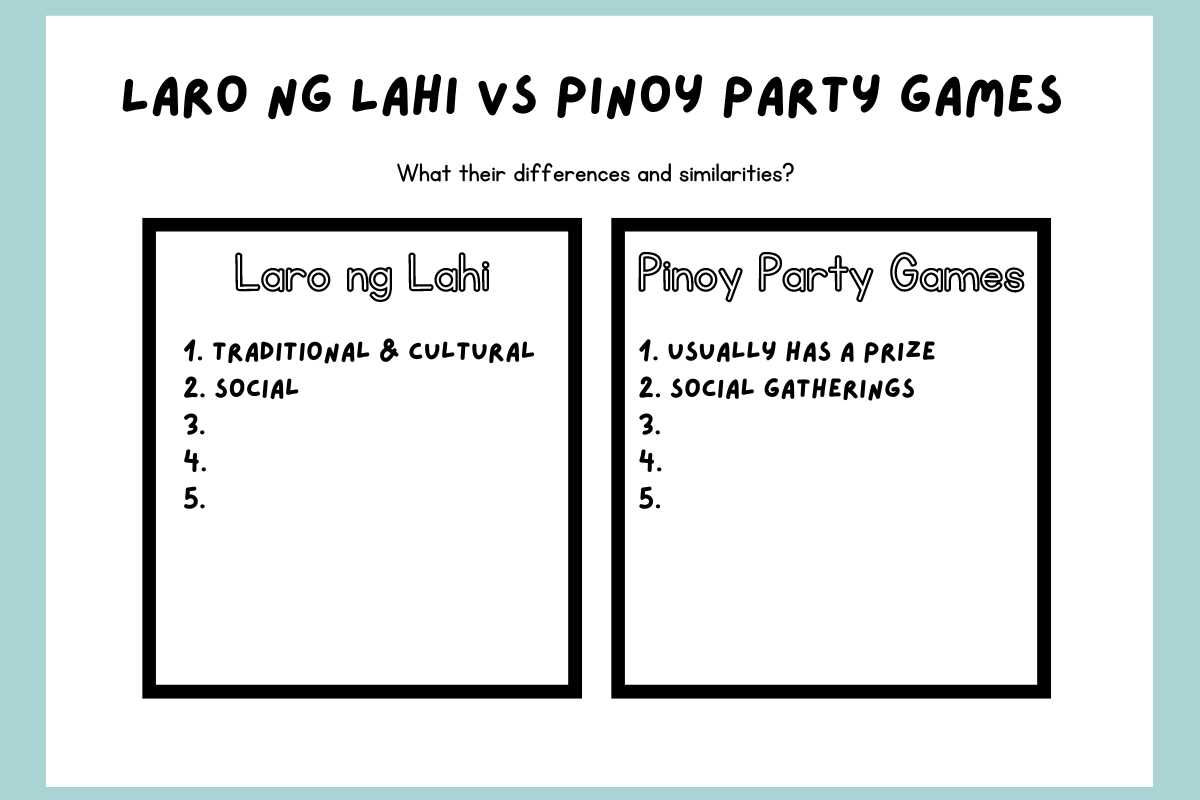Mabuhay! Welcome to a journey that takes us back to the heartwarming lanes of Filipino culture and fun. As a proud Batang 90’s from Pampanga, I’ve seen and experienced the evolution of games in our culture. Today, let’s explore the enchanting world of “Laro ng Lahi” and “Pinoy Party Games,” two pillars of Filipino play that offer more than just entertainment – they’re a celebration of our heritage and communal bonds.
“Laro ng Lahi,” or traditional Filipino games, are the soul of our childhoods, deeply rooted in our history and cultural identity. On the other side, “Pinoy Party Games” represent the modern, fun-filled activities that bring laughter and joy to our parties and gatherings. Both play a significant role in our culture, but in very different ways.
Laro ng Lahi: A Dive into Traditional Filipino Games
Historical Background
Laro ng Lahi is not just a pastime; it’s a living narrative of our history. These games emerged from various facets of Filipino life, influenced by agricultural practices, folklore, and even our struggles for independence. They are more than games; they are stories, teaching us resilience, teamwork, and ingenuity.
Popular Laro ng Lahi Games
Let’s reminisce about the games that colored our childhoods:
- Tumbang Preso: This game, often played with a slipper and a can, is a thrilling chase-and-tag game symbolizing our spirit of defiance and quick thinking.
- Patintero: Known for its lines and grids, patintero teaches strategy and teamwork, as players attempt to block their opponents from passing lines.
- Taguan: Our version of hide and seek, taguan, was not just a game but an adventure, teaching us patience and stealth.
- Sipa: Using a rattan ball, sipa was our way of showcasing agility and grace, a game that even now, resonates with our love for sports.
Cultural Impact
These games were more than mere entertainment. In the streets and fields of Pampanga, they were a communal event, bringing together children and adults alike. They taught us about cooperation, respect, and the joy of simple pleasures. They were a testament to our cultural resilience, surviving through generations despite the onslaught of modernization.
Pinoy Party Games: Modern Fun and Social Bonding
Definition and Evolution
In contrast to the traditional “Laro ng Lahi,” Pinoy Party Games are the vibrant expressions of modern Filipino gatherings. These games have evolved to suit indoor settings, larger groups, and diverse age ranges. They are less about physical prowess and more about quick thinking, creativity, and laughter.
From classic charades to creative adaptations of Pictionary, these games have become a staple in Filipino parties and celebrations.
Examples of Popular Pinoy Party Games
Some of the games that add life to our parties include:
- Charades: Here, players guess words or phrases acted out silently, igniting bursts of laughter and encouraging creativity.
- Pinoy Henyo: A game of guessing words with only “Yes,” “No,” or “Maybe” as clues, testing our wit and patience.
- Bato-bato-pick (Rock-Paper-Scissors): A simple yet thrilling game that decides many matters in a fun and light-hearted way.
The Role in Today’s Society
These games have adapted well to the modern Filipino society, fitting seamlessly into our lively and close-knit communities. They’re not just for entertainment; they’re a way to break the ice, foster teamwork, and create memorable moments. In today’s world, where technology often takes center stage, these games provide a refreshing return to interpersonal interaction and shared laughter.
Comparative Analysis
Gameplay Differences
Laro ng Lahi games are often physically engaging and involve a deeper connection to our cultural past. They require open spaces and physical agility. On the other hand, Pinoy Party Games are more versatile, suitable for indoor settings and often focus on mental agility and creativity.
Cultural Significance
While Laro ng Lahi games connect us to our historical roots and cultural identity, Pinoy Party Games reflect our adaptability and modern social dynamics. Both sets of games are crucial in preserving different facets of our Filipino identity.
Adaptability and Appeal
Laro ng Lahi games have a timeless appeal, captivating young and old alike with their simplicity and connection to our heritage. Pinoy Party Games, being more adaptable and varied, cater to a broader audience, including those who might not be as physically inclined.
Personal Recommendations and Experiences
As someone who cherishes both types of games, let me share a few personal favorites and experiences. “Patintero” holds a special place in my heart for its teamwork and strategy. It reminds me of long summer days spent playing in the streets with friends, a true testament to our camaraderie and childhood innocence.
In the realm of Pinoy Party Games, “Pinoy Henyo” is a top pick for its hilarity and the mental gymnastics it induces. It’s a game that I often play with my family during gatherings, and it never fails to bring us closer, often leaving us in stitches from laughter.
Both sets of games are not just about winning or losing; they’re about the experiences they create and the memories they leave us with. Whether it’s the nostalgic rush of “tumbang preso” or the intellectual challenge of “Bato-bato-pick,” these games have a unique way of bonding people and creating joyous moments.
Laro ng Lahi vs. Pinoy Party Games
In conclusion, Laro ng Lahi and Pinoy Party Games are two vibrant threads in the rich tapestry of Filipino culture. They each offer unique experiences and lessons. Laro ng Lahi connects us to our roots, teaching us about our history and values, while Pinoy Party Games bring us together in the present, fostering creativity and social bonds.
As we embrace the modern world, it’s crucial to remember and cherish these games. They’re not just pastimes; they’re bridges connecting generations, teaching us about who we are and where we come from. So, whether you’re a casual gamer, a family looking for bonding activities, an educator, or a game master, delve into these games. Experience the joy, the laughter, and the rich cultural heritage they bring.
Additional Resources
For those interested in exploring these games further, there are numerous resources available. Local community centers often host events where these games are played. Online forums and websites offer insights and rules for these games. Additionally, cultural festivals and barangay fiestas are excellent opportunities to experience these games firsthand.
In embracing both Laro ng Lahi and Pinoy Party Games, we keep our culture alive and thriving, ensuring that the joys of our past continue to enlighten our present and future.





One thought on “Laro ng Lahi vs Pinoy Party Games: What are their differences & similarities”